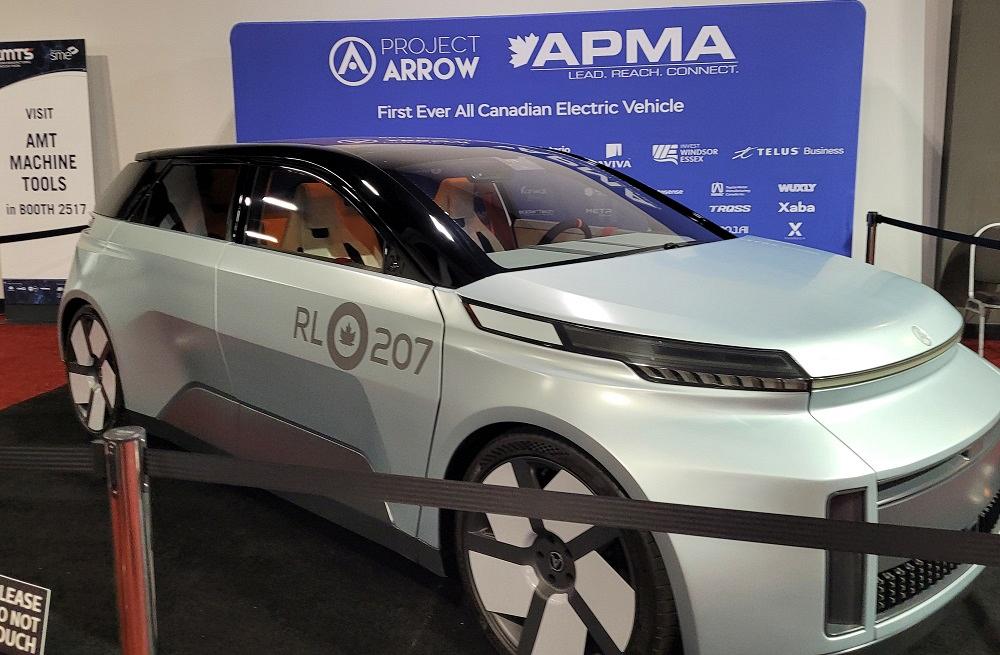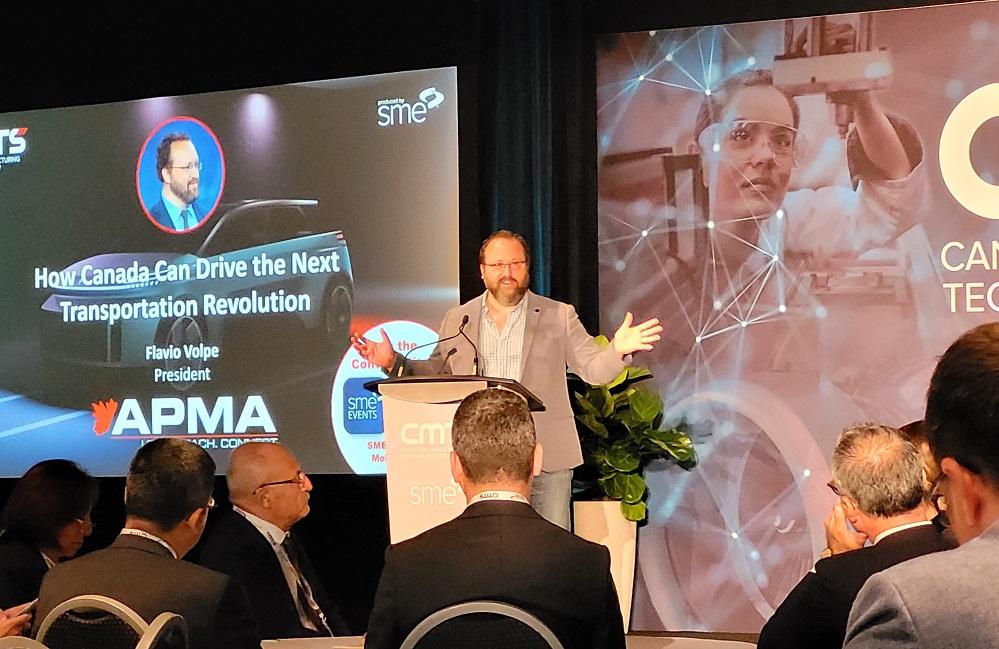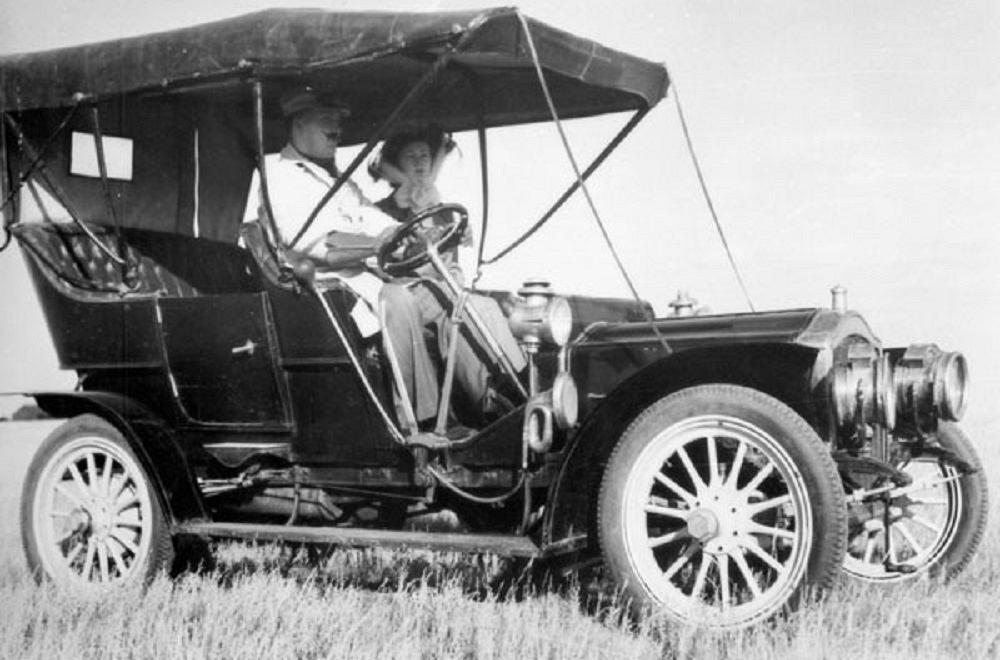- FMA
- The Fabricator
- FABTECH
- Canadian Metalworking
Demonstrating the dignity of manufacturing in Canada
APMA’s Flavio Volpe talks about the future of Canadian auto innovation
- December 6, 2023
- Article
- Made In Canada
Editor’s Note: This article is adapted from “How Canada can drive the next transportation revolution,” by Flavio Volpe, president of the Automotive Parts Manufacturers' Association (APMA), presented at the Canadian Manufacturing Technology Show (CMTS), Sept. 27, 2023, in Toronto.
This is a story about collaboration. Oftentimes, people ask, ‘Why do we collaborate in Canada?’ Is it because Canadians are nice people? It’s possible. But maybe manufacturers are willing to collaborate because Canada doesn’t have its own carmaker.
Manufacturers are not competing with each other in Canada in the same way they are in Detroit or Ann Arbor, where people are loyal to either Chevy or Ford. Everyone has their brand or affiliation, and in some ways they only can look at the world as competing interests.
In Canada, the competing interest is the rest of the world rather than fellow manufacturers. Depending on who's counting, Canada is the tenth largest automaker in the world. Canadian companies have made the Russell Motor car, the McLaughlin-Buick car, and a few others over 100 years ago.
This begs the questions: How does Canada stay relevant in the automotive sector? How does it convince the world to work with Canadian companies? The answer: Canadian companies should seek Canadian resources, work with the Canadian government and Canadian banks, and partner with Canadian toolmakers. The brand that Canadian companies have in common is the flag that they fly. Many companies and organizations have Canada in their name. They work together because they are all Canadian. They all are part of team Canada.
Their challenge, however, is that it is hard to get noticed when it comes to selling Canadian goods or influencing international trade policies. But when Canadian companies work together, they can do it.
In the last few years, the message has been that manufacturing, and especially automotive manufacturing, is a declining industry. No one wants cars, no one wants to build cars, and no one wants to work with their hands. The perception is that there is no dignity in manufacturing.
However, Mexico understands the value of manufacturing, whereas Canada has moved past it to instead focus on the service industry. Now that the conversation has shifted to the high cost of living, manufacturing has the opportunity to shine because manufacturing jobs are the kind that can build sustainable incomes.
One of the biggest challenges the manufacturing industry faces is how to show people its value while it is focused on making things and delivering on deadline. Customers know the value, but regulators, policy-makers, trade delegates, and politicians don’t. It’s on manufacturers to show them.
But there was something else that really sparked people’s interest.
It All Started With NAFTA Renegotiations
When former President Donald Trump got elected, many people paid attention to what he said and did, especially when he said, “Screw Canada.” He said that the U.S. was going to renegotiate NAFTA, and that the U.S. would be the ones to dictate the terms to Mexico. He didn’t realize Canada also was part of NAFTA until someone told him.
All of a sudden, Canadian manufacturers became a target. Politicians, businesspeople, and industry members came to their defence. They got vocal.
The APMA did an inventory of Canadian automotive manufacturing assets across North America, including volume suppliers, toolmakers, and moldmakers.
The inventory revealed that Canadian auto parts companies have more than 120 plants and 44,000 employees in Mexico and 150 plants across 18 U.S. states, employing more than 42,500 workers. Of Canada’s 100,000 automotive workers, 58,000 were employed by Canadian companies. Canadian companies employ more people in the U.S. and Mexico than in Canada because it had to follow its growth markets.
Trump said NAFTA needed a new deal. Well, that was great for Canada and the APMA. The organization represented both American and Mexican investors, and APMA President Flavio Volpe was heavily involved in these NAFTA negotiations.
Volpe decided to call the White House and speak with Gary Cohn, the president’s chief economic advisor. Volpe was connected to someone who asked him who he was and what he wanted. Volpe explained he would be in Washington, D.C., and wanted to discuss the new terms on the rules of origin for automotive. He believed the terms were going to sink suppliers. He got a meeting.
Their plan was to drive more business to U.S. auto suppliers by requiring that 85 per cent of a car to be made in North America and 50 per cent in the U.S. Parts suppliers would have to trace their content down to the raw material.
In a media scrum, a journalist asked Volpe what he thought about this plan. He said, “If you make plastic parts, are we tracing back to bitumen? Are we tracing back to sweet crude? When they say they are going back to the base raw material, what are they talking about? When did the dinosaurs die? And where did they die? And can we claim ownership of that? We need the experts in the U.S. here to tell us how to be compliant, otherwise it’s not going to work.”
At the White House, Volpe met with Cohn’s staffers to discuss how this agreement was not going to work—he felt the deal would kill American auto suppliers and he wanted everyone to know that the U.S. government was responsible.
Instead, new terms were agreed upon, and for the first time in 25 years, it was a deal that could actually work. Canada signed a trade agreement that required more local content for automotive. Before the new deal, 62.5 per cent of a North American-made car, which at the time could be classified into 29 different component baskets, had to be sourced from the region. By 2015, analysis showed that those 29 component baskets now only represented 75 per cent of the vehicle, which meant that only around 53 per cent of the vehicle actually came from the region. The new rules stated that 75 per cent of a vehicle had to originate from the region and, in the different part classes, anywhere from 65 per cent to 75 per cent must come from the region.

A McLaughlin-Buick 1910 Model 41 touring car. Bill Burris from Edmonton, Alberta, Canada, CC BY-SA 2.0, via Wikimedia Commons.
Manufacturers Joined the Fight Against COVID-19
During the COVID-19 global pandemic, the world needed masks, swabs, face shields, ventilators, and other related products. Volpe saw what happened in New York, with bodies being stored in freezer trucks due to overwhelmed morgues, didn’t want that to happen in Canada.
In his talks with the premier and prime minister, Volpe asked them if any Canadian manufacturers were making safety gear. The truth was that there weren’t. He then asked if the province had specs and volume information, because in Ontario, there are 1,400 moldmaking facilities. The industry could help.
On March 16, 2020, Volpe called Canadian manufacturers to action, asking them to step up and help Canada fight the war against COVID-19. In total, 165 part makers, toolmakers, and moldmakers offered to help.
There were detractors, but Volpe knew that the industry could do it. The APMA fully negotiated contract manufacturing agreements with two ventilator companies and dozens of other medical goods companies to build what was needed in Canada immediately. It was a defining moment for Canadian manufacturing, garnering notice from the prime minister, who said that the manufacturing and automotive industry is saving Canada.
Why did these manufacturers do it? Because it was the right thing to do. Volpe explained that it was the most fulfilling thing he’s ever been a part of and one of the most important moments for Canadian manufacturing in the last 10 years. It brought to the forefront the importance of making things and the dignity in making things. While it wasn’t a real war, there were casualties. It was an acute crisis and Canadians solved it themselves.
Taking Steps Forward With Project Arrow
These events were instrumental in leading APMA to build a $20 million car. There wasn’t a carmaker in Canada and the prime minister challenged Canadians to make one.
In the 1950s, Canada had the Avro Arrow—a supersonic interceptor jet aircraft. When the project was killed, all the jobs went with it. Many of the Arrow’s innovators went to other countries to work on projects like the Apollo or Concorde.
Canadians needed to show the world that it still had that innovative spirit. So, the APMA hired astronauts and convinced Fraser Dunn of Aston Martin to join the Project Arrow team. From there, it was able to convince 534 Canadian companies to bid on this project, and eventually 58 actually made components for the car.
The APMA went on a journey with Project Arrow. It built a working prototype from bumper to bumper. The vehicle was unveiled at CES (Consumer Electronics Show) 2023 in Las Vegas. After Volpe presented it, Stellantis CEO Carlos Tavares asked to speak with him privately.
Tavares wanted to know if Stellantis was already working with any of the Project Arrow suppliers. At that time, the carmaker was only working with about 20 of them, but Tavares wanted to know how his company could work with the other 38. That was the point of building this car—to highlight what Canadian manufacturers can offer automakers from around the world.

APMA worked with 58 Canadian automotive suppliers to build an EV concept vehicle, known as Project Arrow.
Canada’s EV Future
Canadian businesses are in a competitive space and must do everything in their power to remain competitive. In 2010, when the world was falling apart due to a recession and the automakers were struggling, the government wrote a check for $13.3 billion to General Motors and Chrysler, who were told to pay their suppliers. They survived.
Today, the federal government committed $13 billion to Volkswagen to build battery cells in St. Thomas, Ont. It’s not a check, it’s a commitment. Volkswagen makes the cells, and based on production levels, and the government will calculate and forgive some of the incremental taxes levied until that $13 billion is reached.
However, the parliamentary budget officer (PBO) released a report that said the deal was bad. The payback was 20 years, not the five years the federal government projected. The opposition jumped on this, and so did the Canadian Taxpayers Federation. They said it's a waste of taxpayer money, and that Canada shouldn’t invest in manufacturing.
In the report, the PBO explained that the only metric it focused on was the economic returns in government revenue on cell manufacturing. It ignored everything else because it wasn't certain that anything else was actually going to happen.
Volpe challenged PBO’s methods and math. He argued that people do not buy battery cells, they buy a Volkswagen ID.4, which includes the cell. When an ID.4 is purchased, so are the tools or parts from the region’s auto parts suppliers and the raw materials from Canadian suppliers. Not to mention, the purchase also benefits the local dealership that sold it.
When Volpe was asked whether he was tired of defending government, he said no. He said the government did the heavy lifting and supported the industry with this deal. If St. Thomas hadn’t gotten a Volkswagen battery plant, it would continue to be the St. Thomas of the past. When Ford left St. Thomas, housing prices dropped, opportunity waned, tax revenue decreased, hope was gone, and people left.
The APMA took action with Project Arrow. As a result, Volpe has had conversations with automakers from around the world throughout the last year. The car will visit Palo Alto, Tokyo, and Dubai before the end of 2023. This project has highlighted Canada’s ability to make the best products to meet this new electrification transition standard.
When making an electric vehicle, it’s critical to have access to toolmakers, part makers, OEMs, critical minerals. As such, only one place on the map that contains them all: the province of Ontario and to some degree, Quebec.
This is important because trade negotiations for the United States-Mexico-Canada Agreement (USMCA) will take place in the next few years, and Canada may be negotiating the new one with Donald Trump, who is in the middle of a presidential bid.
The best way for Canadian manufacturers to survive any changes to USMCA mandates is to make a product that is cost-competitive and high quality while maintaining a low carbon footprint throughout the entire supply chain. While the government currently wants 100 per cent EVs, the reality is that it will probably be closer to 35 per cent by 2035, and that gap is going to be evident in 2028.
In the meantime, there will be new presidents, prime ministers, premiers, and governors. While future targets are unknown, initiatives that address climate change aren’t going to go backwards, so it might be wise for manufacturers and parts suppliers to switch vehicle mandates that will benefit the carbon footprint of their entire enterprise. Soon, it will matter that a tool originates from a 90 per cent carbon-free jurisdiction; that steel originates from ArcelorMittal Dofasco, which has invested heavily in decarbonization of its products; that lithium comes from Quebec; and that parts are manufactured here.
The APMA brought the Project Arrow car to the Canadian International AutoShow in Toronto in February. It was the first time in 50 years that a Canadian car, a non-OE car, was the feature car.
It’s proof that Canadian manufacturers are recommitting to the automotive sector. They are leaders in additive manufacturing, AI, and machine learning, and they can show the world how to make profitable quality cars on short runs.
Perhaps a young person who saw Project Arrow will be inspired to launch his or her own car company. The APMA and Canadian manufacturers are following in the great tradition of people like Henry Ford, Enzo Ferrari, and Togg in Turkey. It's not magic. The desire to do it and invest money and resources toward it must be a priority. Canadians are starting to think like that now.
subscribe now


Keep up to date with the latest news, events, and technology for all things metal from our pair of monthly magazines written specifically for Canadian manufacturers!
Start Your Free Subscription- Trending Articles
Automating additive manufacturing

Sustainability Analyzer Tool helps users measure and reduce carbon footprint

CTMA launches another round of Career-Ready program

Sandvik Coromant hosts workforce development event empowering young women in manufacturing

GF Machining Solutions names managing director and head of market region North and Central Americas

- Industry Events
MME Winnipeg
- April 30, 2024
- Winnipeg, ON Canada
CTMA Economic Uncertainty: Helping You Navigate Windsor Seminar
- April 30, 2024
- Windsor, ON Canada
CTMA Economic Uncertainty: Helping You Navigate Kitchener Seminar
- May 2, 2024
- Kitchener, ON Canada
Automate 2024
- May 6 - 9, 2024
- Chicago, IL
ANCA Open House
- May 7 - 8, 2024
- Wixom, MI

















